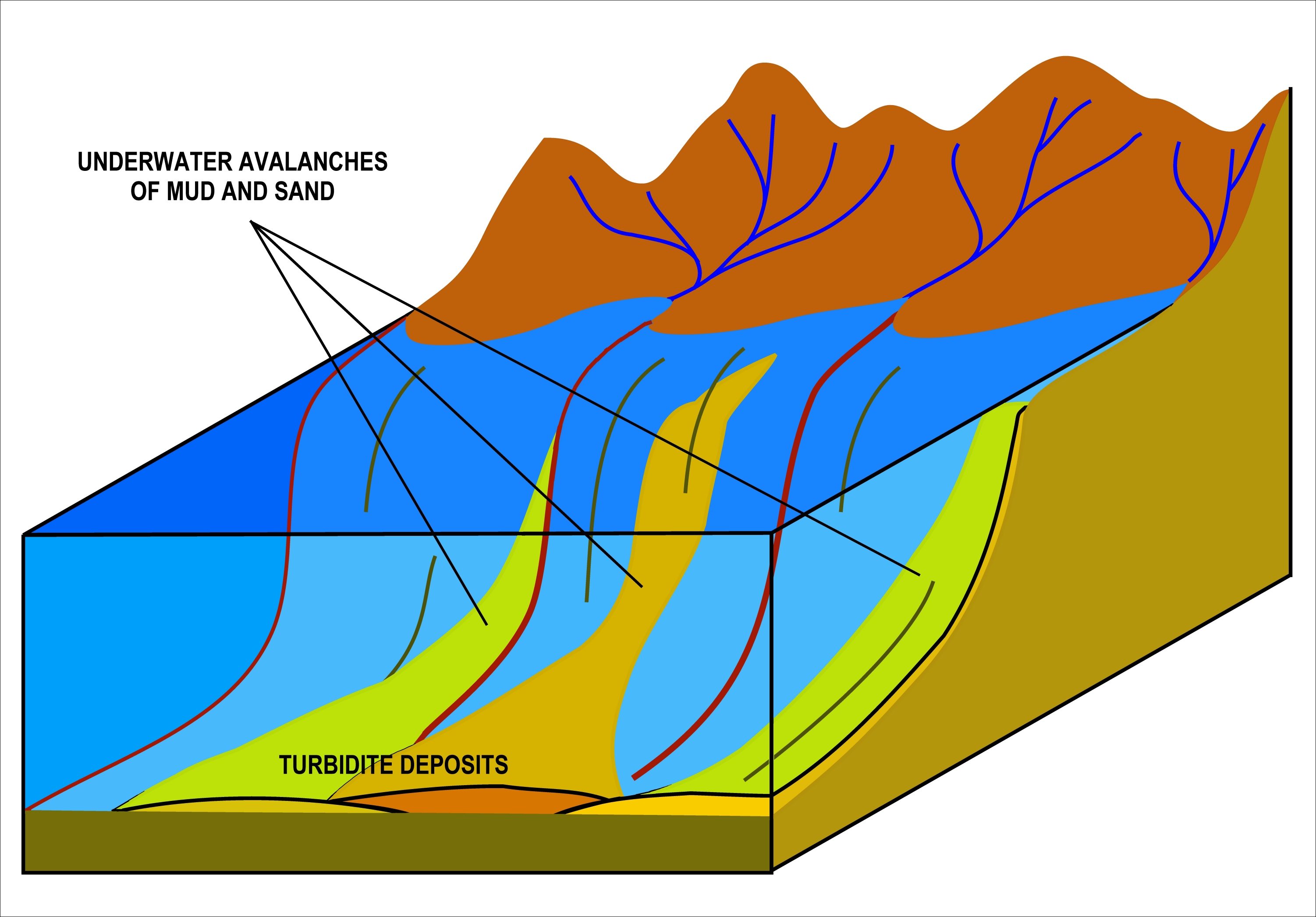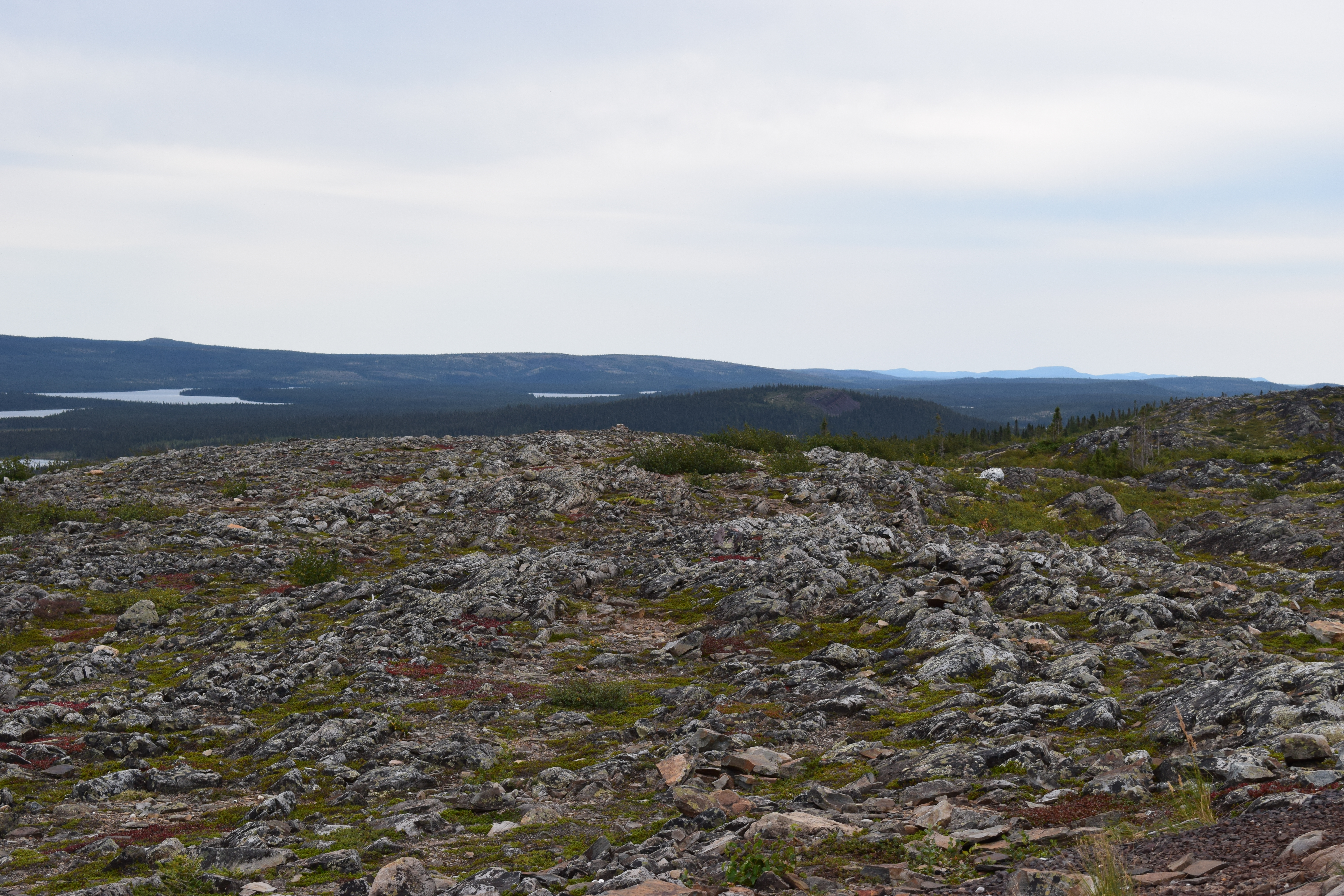|
Northwest Atlantic Mid-Ocean Channel
The Northwest Atlantic Mid-Ocean Channel (NAMOC) is the main body of a turbidity current system of channels and canyons running on the sea bottom from the Hudson Strait, through the Labrador Sea, and ending at the Sohm Abyssal Plain in the Atlantic Ocean. Contrary to most other such systems which fan away from the main channel, numerous tributaries run into the NAMOC and end there. The density of those tributaries is the highest near the Labrador Peninsula, but the longest tributary, called Imarssuak Mid-Ocean Channel (IMOC), originates in the Atlantic Ocean. Most topography data on the NAMOC originate from wide-range sonar scans. With a total length of about , NAMOC is one of the longest underwater channels in the world. It is 100–200 m deep and 2–5 km wide at the channel floor. The rising levees of the NAMOC (about 100 m above the sea bed) often hinder confluence of some tributaries, which instead run along NAMOC for hundreds of km. Its western (right-hand, max. height 25 ... [...More Info...] [...Related Items...] OR: [Wikipedia] [Google] [Baidu] |
Turbidity Current
A turbidity current is most typically an Ocean current, underwater current of usually rapidly moving, sediment-laden water moving down a slope; although current research (2018) indicates that water-saturated sediment may be the primary actor in the process. Turbidity currents can also occur in other fluids besides water. Researchers from the Monterey Bay Aquarium Research Institute found that a layer of water-saturated sediment moved rapidly over the seafloor and mobilized the upper few meters of the preexisting seafloor. Plumes of sediment-laden water were observed during turbidity current events but they believe that these were secondary to the pulse of the seafloor sediment moving during the events. The belief of the researchers is that the water flow is the tail-end of the process that starts at the seafloor. In the most typical case of oceanic turbidity currents, sediment laden waters situated over sloping ground will flow down-hill because they have a higher density th ... [...More Info...] [...Related Items...] OR: [Wikipedia] [Google] [Baidu] |
Hudson Strait
Hudson Strait () in Nunavut links the Atlantic Ocean and the Labrador Sea to Hudson Bay in Canada. This strait lies between Baffin Island and Nunavik, with its eastern entrance marked by Cape Chidley in Newfoundland and Labrador and Nunavut and Resolution Island (Nunavut), Resolution Island, off Baffin Island. The strait is about long with an average width of , varying from at the eastern entrance to at Deception Bay. English navigator Sir Martin Frobisher was the first European to report entering the strait, in 1578. He named a tidal rip at the entrance the Furious Overfall and called the strait ''Mistaken Strait'', since he felt it held less promise as an entrance to the Northwest Passage than the body of water that was later named Frobisher Bay. Later in his 1587 voyage, explorer John Davis (explorer), John Davis sailed by the entrance to the strait. The first European to explore the strait was George Weymouth who sailed beyond the Furious Overfall in 1602. The strait ... [...More Info...] [...Related Items...] OR: [Wikipedia] [Google] [Baidu] |
Labrador Sea
The Labrador Sea (; ) is an arm of the North Atlantic Ocean between the Labrador Peninsula and Greenland. The sea is flanked by continental shelf, continental shelves to the southwest, northwest, and northeast. It connects to the north with Baffin Bay through the Davis Strait. It is a marginal sea of the Atlantic. The sea formed upon separation of the North American Plate and Greenland Plate that started about 60 million years ago and stopped about 40 million years ago. It contains one of the world's largest turbidity current channel systems, the Northwest Atlantic Mid-Ocean Channel (NAMOC), that runs for thousands of kilometers along the sea bottom toward the Atlantic Ocean. The Labrador Sea is a major source of the North Atlantic Deep Water, a cold water mass that flows at great depth along the western edge of the North Atlantic. History The Labrador Sea formed upon separation of the North American Plate and Greenland Plate that started about 60 million years ago (Paleocene) ... [...More Info...] [...Related Items...] OR: [Wikipedia] [Google] [Baidu] |
Sohm Abyssal Plain
The Sohm Abyssal Plain is in the North Atlantic and has an area of around . It is located off the coast of the Canadian Maritime provinces and New England in the United States. The region was named for Rudolf von Willemoes-Suhm, a German naturalist on the Challenger expedition The ''Challenger'' expedition of 1872–1876 was a scientific programme that made many discoveries to lay the foundation of oceanography. The expedition was named after the naval vessel that undertook the trip, . The expedition, initiated by W ... in the late-19th Century. References Abyssal plains Landforms of the Atlantic Ocean {{marine-geo-stub ... [...More Info...] [...Related Items...] OR: [Wikipedia] [Google] [Baidu] |
Atlantic Ocean
The Atlantic Ocean is the second largest of the world's five borders of the oceans, oceanic divisions, with an area of about . It covers approximately 17% of Earth#Surface, Earth's surface and about 24% of its water surface area. During the Age of Discovery, it was known for separating the New World of the Americas (North America and South America) from the Old World of Afro-Eurasia (Africa, Asia, and Europe). Through its separation of Afro-Eurasia from the Americas, the Atlantic Ocean has played a central role in the development of human society, globalization, and the histories of many nations. While the Norse colonization of North America, Norse were the first known humans to cross the Atlantic, it was the expedition of Christopher Columbus in 1492 that proved to be the most consequential. Columbus's expedition ushered in an Age of Discovery, age of exploration and colonization of the Americas by European powers, most notably Portuguese Empire, Portugal, Spanish Empire, Sp ... [...More Info...] [...Related Items...] OR: [Wikipedia] [Google] [Baidu] |
Tributary
A tributary, or an ''affluent'', is a stream or river that flows into a larger stream (''main stem'' or ''"parent"''), river, or a lake. A tributary does not flow directly into a sea or ocean. Tributaries, and the main stem river into which they flow, drain the surrounding drainage basin of its surface water and groundwater, leading the water out into an ocean, another river, or into an endorheic basin. The Irtysh is a chief tributary of the Ob (river), Ob river and is also the longest tributary river in the world with a length of . The Madeira River is the largest tributary river by volume in the world with an average discharge of . A confluence, where two or more bodies of water meet, usually refers to the joining of tributaries. The opposite to a tributary is a distributary, a river or stream that branches off from and flows away from the main stream. [...More Info...] [...Related Items...] OR: [Wikipedia] [Google] [Baidu] |
Labrador Peninsula
The Labrador Peninsula, also called Quebec-Labrador Peninsula, is a large peninsula in eastern Canada. It is bounded by Hudson Bay to the west, the Hudson Strait to the north, the Labrador Sea to the east, Strait of Belle Isle and the Gulf of St. Lawrence to the southeast. The peninsula includes the region of Labrador, which is part of the province of Newfoundland and Labrador Newfoundland and Labrador is the easternmost province of Canada, in the country's Atlantic region. The province comprises the island of Newfoundland and the continental region of Labrador, having a total size of . As of 2025 the populatio ..., and the regions of Saguenay–Lac-Saint-Jean, Côte-Nord, and Nord-du-Québec, which are in the province of Quebec. It has an area of . Location and geography The peninsula is surrounded by sea on all sides, except for the southwest where it widens into the general continental mainland. The northwestern part of the Labrador Peninsula is shaped as a les ... [...More Info...] [...Related Items...] OR: [Wikipedia] [Google] [Baidu] |
Side-scan Sonar
Side-scan sonar (also sometimes called side scan sonar, sidescan sonar, side imaging sonar, side-imaging sonar and bottom classification sonar) is a category of sonar system that is used to efficiently create an image of large areas of the sea floor. Uses Side scan sonar is used to image large areas of the seafloor quickly. Applications include surveys for marine archaeology, shipwreck hunting, search and recovery (SAR), and environmental monitoring. In conjunction with seafloor samples, it is able to provide an understanding of the differences in material and texture type of the seabed. Side-scan sonar imagery is also a commonly used tool to detect debris items and other obstructions on the seafloor that may be hazardous to shipping or to seafloor installations by the oil and gas industry. In addition, the status of pipelines and cables on the seafloor can be investigated using side-scan sonar. Side-scan data are frequently acquired along with bathymetric soundings and s ... [...More Info...] [...Related Items...] OR: [Wikipedia] [Google] [Baidu] |
Levee
A levee ( or ), dike (American English), dyke (British English; see American and British English spelling differences#Miscellaneous spelling differences, spelling differences), embankment, floodbank, or stop bank is an elevated ridge, natural or artificial, alongside the river banks, banks of a river, often intended to flood control, protect against flooding of the area adjoining the river. It is usually soil, earthen and often runs parallel (geometry), parallel to the course of a river in its floodplain or along low-lying coastlines. Naturally occurring levees form on river floodplains following flooding. Sediment and alluvium are deposition (geology), deposited on the banks and settle, forming a ridge that increases the river channel's capacity. Alternatively, levees can be artificially constructed from fill dirt, fill, designed to regulate water levels. In some circumstances, artificial levees can be environmental degradation, environmentally damaging. Ancient civilization ... [...More Info...] [...Related Items...] OR: [Wikipedia] [Google] [Baidu] |
Coriolis Effect
In physics, the Coriolis force is a pseudo force that acts on objects in motion within a frame of reference that rotates with respect to an inertial frame. In a reference frame with clockwise rotation, the force acts to the left of the motion of the object. In one with anticlockwise (or counterclockwise) rotation, the force acts to the right. Deflection of an object due to the Coriolis force is called the Coriolis effect. Though recognized previously by others, the mathematical expression for the Coriolis force appeared in an 1835 paper by French scientist Gaspard-Gustave de Coriolis, in connection with the theory of water wheels. Early in the 20th century, the term ''Coriolis force'' began to be used in connection with meteorology. Newton's laws of motion describe the motion of an object in an inertial (non-accelerating) frame of reference. When Newton's laws are transformed to a rotating frame of reference, the Coriolis and centrifugal accelerations appear. When applied ... [...More Info...] [...Related Items...] OR: [Wikipedia] [Google] [Baidu] |
Amazon Canyon
The Amazon Canyon is a submarine canyon within the Amazon Fan in the Atlantic Ocean, located approximately from the mouth of the Amazon River, near South America. It covers an area of .John E. Damuth, Naresh Kumar, GSA Bulletin; June 1975; v. 86; no. 6; p. 863–878; , available a It was formed in the mid to Late Miocene, late Miocene period. The canyon is believed to have formed through mass failures, and subsequently evolved through underwater erosion.William R. Normark and Paul R. Carlson, "Giant submarine canyons: Is size any clue to their importance in the rock record?", Extreme depositional environments: mega end members in geologic time, Geological Society of America: Boulder, Colorado, 2003, p 184. Because of its relatively small size, the canyon has been extensively mapped. Technical background and channel lobes Continental shelves off major river deltas and estuaries act as interfaces between terrestrial environments and depositional regimes in the deep sea. They ser ... [...More Info...] [...Related Items...] OR: [Wikipedia] [Google] [Baidu] |



